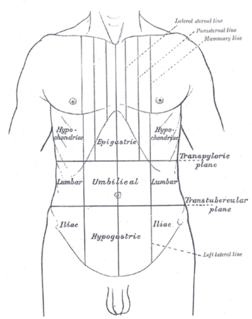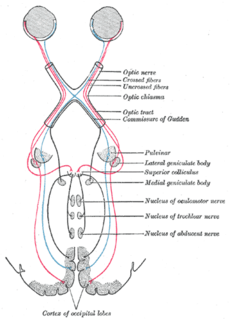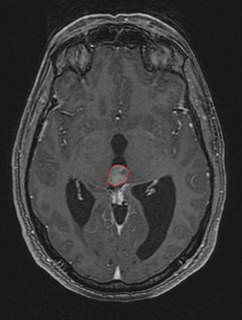Related Research Articles

A lower gastrointestinal series is a medical procedure used to examine and diagnose problems with the human colon. Radiographs are taken while barium sulfate, a radiocontrast agent, fills the colon via an enema through the rectum.

Abdominal pain, also known as a stomach ache, is a symptom associated with both non-serious and serious medical issues.

Rectal prolapse is when the rectal walls have prolapsed to a degree where they protrude out the anus and are visible outside the body. However, most researchers agree that there are 3 to 5 different types of rectal prolapse, depending on if the prolapsed section is visible externally, and if the full or only partial thickness of the rectal wall is involved.

A Meckel's diverticulum, a true congenital diverticulum, is a slight bulge in the small intestine present at birth and a vestigial remnant of the omphalomesenteric duct. It is the most common malformation of the gastrointestinal tract and is present in approximately 2% of the population, with males more frequently experiencing symptoms.

Intussusception is a medical condition in which a part of the intestine folds into the section immediately ahead of it. It typically involves the small bowel and less commonly the large bowel. Symptoms include abdominal pain which may come and go, vomiting, abdominal bloating, and bloody stool. It often results in a small bowel obstruction. Other complications may include peritonitis or bowel perforation.

Duane syndrome is a congenital rare type of strabismus most commonly characterized by the inability of the eye to move outward. The syndrome was first described by ophthalmologists Jakob Stilling (1887) and Siegmund Türk (1896), and subsequently named after Alexander Duane, who discussed the disorder in more detail in 1905.
In topology, a branch of mathematics, a retraction is a continuous mapping from a topological space into a subspace that preserves the position of all points in that subspace. The subspace is then called a retract of the original space. A deformation retraction is a mapping that captures the idea of continuously shrinking a space into a subspace.

A respiratory examination, or lung examination, is performed as part of a physical examination, in response to respiratory symptoms such as shortness of breath, cough, or chest pain, and is often carried out with a cardiac examination.

Parinaud's syndrome is an inability to move the eyes up and down. It is caused by compression of the vertical gaze center at the rostral interstitial nucleus of medial longitudinal fasciculus (riMLF). The eyes lose the ability to move upward and down.
Intussusception may refer to:
In mathematics, a projection is a mapping of a set into a subset, which is equal to its square for mapping composition. The restriction to a subspace of a projection is also called a projection, even if the idempotence property is lost. An everyday example of a projection is the casting of shadows onto a plane. The projection of a point is its shadow on the paper sheet. The shadow of a point on the paper sheet is this point itself (idempotency). The shadow of a three-dimensional sphere is a closed disk. Originally, the notion of projection was introduced in Euclidean geometry to denote the projection of the Euclidean space of three dimensions onto a plane in it, like the shadow example. The two main projections of this kind are:

A pinealoma is a tumor of the pineal gland, a part of the brain that produces melatonin. If a pinealoma destroys the cells of the pineal gland in a child, it can cause precocious puberty.

Distal intestinal obstruction syndrome (DIOS) involves obstruction of the distal part of the small intestines by thickened intestinal content and occurs in about 20% of mainly adult individuals with cystic fibrosis. DIOS was previously known as meconium ileus equivalent, a name which highlights its similarity to the intestinal obstruction seen in newborn infants with cystic fibrosis. DIOS tends to occur in older individuals with pancreatic insufficiency. Individuals with DIOS may be predisposed to bowel obstruction, though it is a separate entity than true constipation.

In category theory, a branch of mathematics, a section is a right inverse of some morphism. Dually, a retraction is a left inverse of some morphism. In other words, if f : X → Y and g : Y → X are morphisms whose composition fog : Y → Y is the identity morphism on Y, then g is a section of f, and f is a retraction of g.

An abdominal x-ray is an x-ray of the abdomen. It is sometimes abbreviated to AXR, or KUB.
Stellwag's sign is a sign of infrequent or incomplete blinking associated with exophthalmos or Graves orbitopathy. It is accompanied by Dalrymple's sign, which is a retraction of the upper eyelids resulting in an apparent widening of the palpebral opening.

Defecography is a type of medical radiological imaging in which the mechanics of a patient's defecation are visualized in real time using a fluoroscope. The anatomy and function of the anorectum and pelvic floor can be dynamically studied at various stages during defecation.
Obstructed defecation, is "difficulty in evacuation or emptying the rectum [which] may occur even with frequent visits to the toilet and even with passing soft motions". The conditions that can create the symptom are sometimes grouped together as defecation disorders. The symptom tenesmus is a closely related topic. Another source defines evacuatory dysfunction as "a constellation of symptoms such as prolonged repeated straining at bowel movements, sensation of incomplete evacuation, and the need for digital manipulation".

The human abdomen is divided into quadrants and regions by anatomists and physicians for the purposes of study, diagnosis, and treatment. The division into four quadrants allows the localisation of pain and tenderness, scars, lumps, and other items of interest, narrowing in on which organs and tissues may be involved. The quadrants are referred to as the left lower quadrant, left upper quadrant, right upper quadrant and right lower quadrant. These terms are not used in comparative anatomy, since most other animals do not stand erect.

Madanur Ahmed Ali, is an Indian surgical gastroenterologist from Chennai. An alumnus of Madras Medical College, he is credited with several publications in peer reviewed journals. The Government of India honored Ali in 2011, with the fourth highest civilian award of Padma Shri.